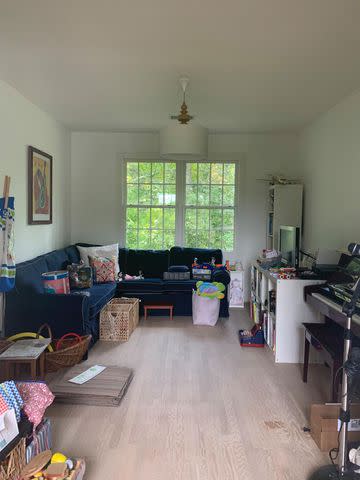7 Things I Learned From Turning A Playroom Into A Home Office

When we bought this 1952 farmhouse in Birmingham about a decade ago, we had different priorities. Because our kids were still little, we were less concerned about decorating than managing the chaos of childhood. We designated an extra space upstairs as a playroom, which eventually filled up with board games, American Girl doll outfits, Lego blocks, costumes, a Nintendo Wii, a sizable collection of Thomas & Friends train cars, an upright piano, childrens’ books, and a small teepee. It was the kind of place where you could injure yourself by stepping on a Matchbox car or tripping over a Stormtrooper helmet, but it defied attempts at organization, chewing up whole Saturdays with no discernible progress. Other than some Ikea bookshelves, the only furniture was an old blue sectional couch that at times had Goldfish crackers wedged between the cushions. We occasionally talked about fixing it up, but other things always took precedence.

Sid Evans
Then the pandemic hit. Suddenly I was working from home all the time and setting up a computer in our dining room. I started thinking about how nice that space could be as an office. It had big windows on either side with a view of the yard, and the square footage could easily accommodate bookshelves, a desk, and maybe even a sofa. I couldn’t envision a calm, productive environment in the midst of all that chaos, so I sent a photo of the room to Fran Keenan, an interior designer in Birmingham.
Meet The Expert
Fran Keenan is an interior designer based in Birmingham, Alabama
Getting Started On The Makeover
Fran has worked with us on several design projects, and she has a way of knowing exactly what you want—and then making it happen. First, she had a few questions for me. What did I need the space for? (Reading? Zoom meetings? Desk work?) What time of day did I want to use it? And how did I want it to feel (bright and airy or moody and compelling)? Once I’d answered those, the room came into focus.
We started with a mid-century desk we found on First Dibs, and Fran used that as a centerpiece. She suggested a light, textured wallpaper and a dark trim, which immediately transformed the space. A striped blue rug and a Lee Industries sofa made it feel comfortable, and modular shelves and cabinets provided much-needed storage. After that, it was just a matter of adding some inspiration—a picture of Willie Nelson (by former staff photographer Art Meripol), some old covers of The New Yorker from my brother, a 1930s-era ukelele from my grandmother, and (of course) the last few years of Southern Living.
Lessons I Learned From This Project
1. Ask for Help
After looking at that messy playroom for so long, I couldn’t imagine it being anything else. Whether it’s an interior designer or just a friend who has good taste, sometimes a fresh perspective can help you see things in a new way. Fran understood that I wanted something comfortable without being too stuffy or traditional. She also proposed a layout that made sense, with shelving on one wall and seating on the other.
2. Think About Your Priorities
For me, the top priority was a quiet space where I could do Zoom calls, record podcasts, make phone calls, and write, so it made sense to use a room upstairs. I also needed a comfortable place to read, and the Lee Industries sectional fit the bill - and the room - perfectly.
3. Invest In A Great Desk
If you’re going to spend a lot of time at your desk, like I do, make it a good one. My wife, Susan, found this old mid-century beauty on 1st Dibs, and I love the dark mahogany, the secret compartments, and the clean modern lines. Antique stores and estate sales can also be great sources.
4. Surround Yourself With Things You Love
As a creative person, I need a little inspiration from photographs, books, musical instruments, and souvenirs from my travels. When I’m dealing with a case of writer’s block, I’ll sometimes pick up an old magazine or a book by an inspiring author.
5. Be Smart About Storage
I’ve accumulated a lot of papers, files, magazines, and books over the years, and I like having them at arm’s reach, so storage was important. Fran suggested some modular shelving from West Elm, which was very functional but not terribly expensive. I also love that it brought a little modern contrast to a pretty traditional space.
Related: Our Most Inspiring Before & After Makeovers
6. Think About Lighting
The room gets a lot of natural light, but I wanted several other sources to give the office some warmth and character. The rattan fixture from Pottery Barn was an affordable solution, and I liked the old-school lamp on the desk as a throwback. One mistake I made was to situate the desk with my back to the window, which is problematic for Zoom calls. If you spend a lot of time on video, it’s better to have natural light coming from the side or in front of you.
7. Bring The Outdoors In
Research suggests that plants improve productivity in the workspace, and they can also improve your mood. I’ve loved having a low-maintenance ficus in my office, and I’m also fond of succulents. If nothing else, watering your plants is a great way to procrastinate when you need a break!
Related: See How This Designer Fills A New Home With Her Favorite Old-House Moves
For more Southern Living news, make sure to sign up for our newsletter!
Read the original article on Southern Living.

